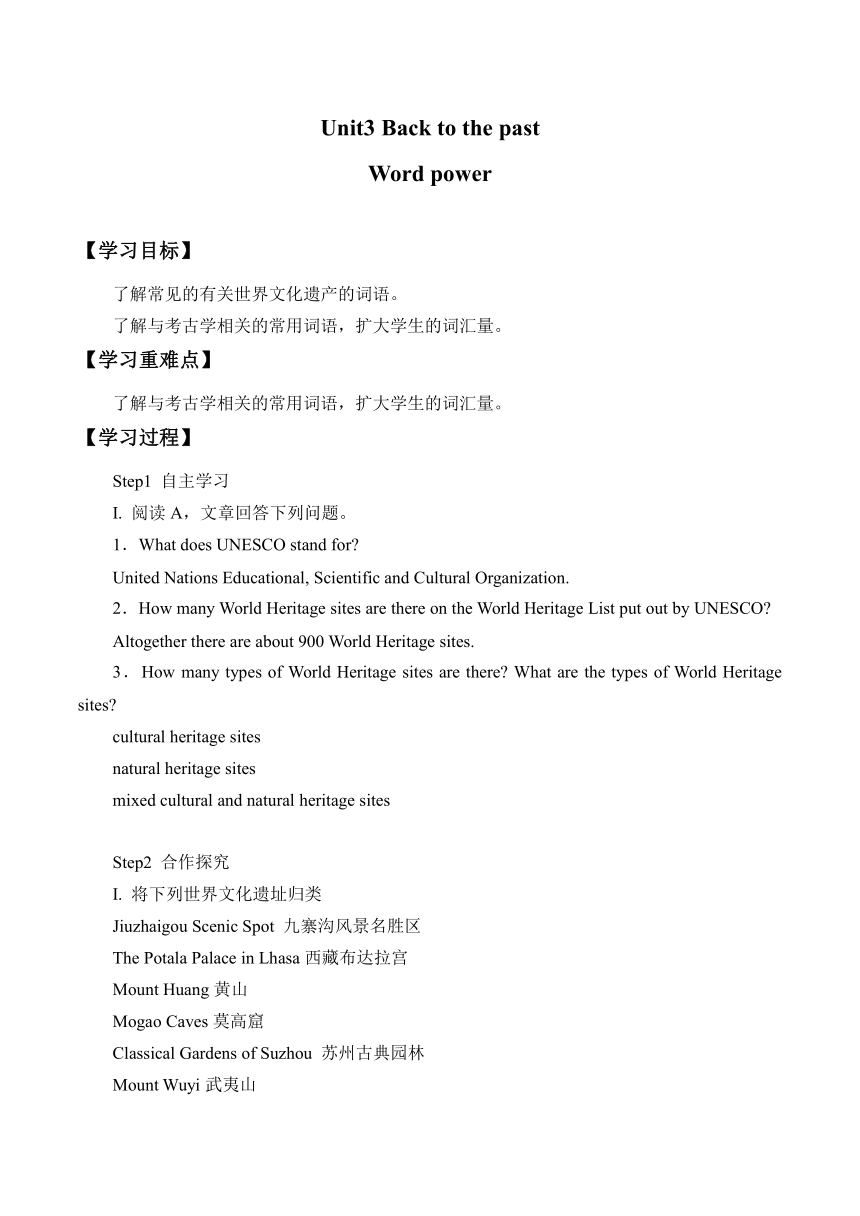牛津泽林版高中英语必修3 - Unit3 Back to the past Word power_学案1
文档属性
| 名称 | 牛津泽林版高中英语必修3 - Unit3 Back to the past Word power_学案1 |  | |
| 格式 | zip | ||
| 文件大小 | 12.2KB | ||
| 资源类型 | 教案 | ||
| 版本资源 | 牛津译林版 | ||
| 科目 | 英语 | ||
| 更新时间 | 2020-03-20 22:57:12 | ||
图片预览

文档简介
Unit3 Back to the past
Word power
【学习目标】
了解常见的有关世界文化遗产的词语。
了解与考古学相关的常用词语,扩大学生的词汇量。
【学习重难点】
了解与考古学相关的常用词语,扩大学生的词汇量。
【学习过程】
Step1 自主学习
I. 阅读A,文章回答下列问题。
1.What does UNESCO stand for?
United Nations Educational, Scientific and Cultural Organization.
2.How many World Heritage sites are there on the World Heritage List put out by UNESCO?
Altogether there are about 900 World Heritage sites.
3.How many types of World Heritage sites are there? What are the types of World Heritage sites?
cultural heritage sites
natural heritage sites
mixed cultural and natural heritage sites
Step2 合作探究
I. 将下列世界文化遗址归类
Jiuzhaigou Scenic Spot 九寨沟风景名胜区
The Potala Palace in Lhasa西藏布达拉宫
Mount Huang黄山
Mogao Caves莫高窟
Classical Gardens of Suzhou 苏州古典园林
Mount Wuyi武夷山
Wulingyuan Scenic Spot武陵源风景名胜区
Mt.Emei and Leshan Giant Buddha峨眉山-乐山大佛
Huanglong Scenic Spot黄龙风景名胜区
cultural heritage sites
Mogao Caves
The Potala Palace in Lhasa
Classical Gardens of Suzhou
natural heritage sites
Huanglong Scenic and Historic Interest Area
Jiuzhaigou Scenic Spot
Wulingyuan Scenic Spot
mixed cultural and natural heritage sites
Mount Wuyi
Mount Huang
Mt.Emei and Leshan Giant Buddha
II. 将下例有关考古学的词汇与释义配对。
1.archaeology a.to write down to make it known
2.archaeologist b.to break away and move earth
3.archaeological site c.to take away from a place
4.brush d.the study of the buried remains of ancient times
5.dig e.to travel into or through a place for the purpose of discovery
6.discover f.the person who studies archaeology
7.explore g.to clean or smooth with a brush
8.remove h.the area being studied
9.record i.to find sth. existing but not known
Step3巩固提高
I. 翻译下列词语
1.cultural heritage site 文化遗址
2.natural heritage sites 自然遗址
3.mixed cultural and natural heritage sites 文化与自然混合遗址
4.archaeology 考古学
5.archaeologist 考古学家
6.archaeological 考古学的
II. 用方框内所给词的正确形式填空。
archaeology archaeologist discovery dig in other words at the same time
Many people think that archaeology is just a bunch of (1)digging in the dirt to see what kind of tools people used a long time ago. But the recent (2)discoveries at Caral in South America gave historians and archaeologists a chance to create new theories and beliefs.
It seems that people lived in Caral (which was in what is now Peru) 4600 years ago, a full 1500 years before anybody thought they were there. (3)At the same time the Egyptians were building the Pyramids, the people of Caral were building their own pyramids.
(4)Archaeologists have discovered that the six pyramids uncovered so far were of different heights, each one surrounded by a group of buildings whose inhabitants (居民) had wealth and status according to where they lived.(5)In other words, the richest and most important lived around the tallest pyramid; His poorest people lived around the shortest pyramid, and so on.
History isn’t boring.(6)Archaeology isn’t all about dirt. They are both ways of studying the past. And contrary to popular belief, the stories are always changing.
Word power
【学习目标】
了解常见的有关世界文化遗产的词语。
了解与考古学相关的常用词语,扩大学生的词汇量。
【学习重难点】
了解与考古学相关的常用词语,扩大学生的词汇量。
【学习过程】
Step1 自主学习
I. 阅读A,文章回答下列问题。
1.What does UNESCO stand for?
United Nations Educational, Scientific and Cultural Organization.
2.How many World Heritage sites are there on the World Heritage List put out by UNESCO?
Altogether there are about 900 World Heritage sites.
3.How many types of World Heritage sites are there? What are the types of World Heritage sites?
cultural heritage sites
natural heritage sites
mixed cultural and natural heritage sites
Step2 合作探究
I. 将下列世界文化遗址归类
Jiuzhaigou Scenic Spot 九寨沟风景名胜区
The Potala Palace in Lhasa西藏布达拉宫
Mount Huang黄山
Mogao Caves莫高窟
Classical Gardens of Suzhou 苏州古典园林
Mount Wuyi武夷山
Wulingyuan Scenic Spot武陵源风景名胜区
Mt.Emei and Leshan Giant Buddha峨眉山-乐山大佛
Huanglong Scenic Spot黄龙风景名胜区
cultural heritage sites
Mogao Caves
The Potala Palace in Lhasa
Classical Gardens of Suzhou
natural heritage sites
Huanglong Scenic and Historic Interest Area
Jiuzhaigou Scenic Spot
Wulingyuan Scenic Spot
mixed cultural and natural heritage sites
Mount Wuyi
Mount Huang
Mt.Emei and Leshan Giant Buddha
II. 将下例有关考古学的词汇与释义配对。
1.archaeology a.to write down to make it known
2.archaeologist b.to break away and move earth
3.archaeological site c.to take away from a place
4.brush d.the study of the buried remains of ancient times
5.dig e.to travel into or through a place for the purpose of discovery
6.discover f.the person who studies archaeology
7.explore g.to clean or smooth with a brush
8.remove h.the area being studied
9.record i.to find sth. existing but not known
Step3巩固提高
I. 翻译下列词语
1.cultural heritage site 文化遗址
2.natural heritage sites 自然遗址
3.mixed cultural and natural heritage sites 文化与自然混合遗址
4.archaeology 考古学
5.archaeologist 考古学家
6.archaeological 考古学的
II. 用方框内所给词的正确形式填空。
archaeology archaeologist discovery dig in other words at the same time
Many people think that archaeology is just a bunch of (1)digging in the dirt to see what kind of tools people used a long time ago. But the recent (2)discoveries at Caral in South America gave historians and archaeologists a chance to create new theories and beliefs.
It seems that people lived in Caral (which was in what is now Peru) 4600 years ago, a full 1500 years before anybody thought they were there. (3)At the same time the Egyptians were building the Pyramids, the people of Caral were building their own pyramids.
(4)Archaeologists have discovered that the six pyramids uncovered so far were of different heights, each one surrounded by a group of buildings whose inhabitants (居民) had wealth and status according to where they lived.(5)In other words, the richest and most important lived around the tallest pyramid; His poorest people lived around the shortest pyramid, and so on.
History isn’t boring.(6)Archaeology isn’t all about dirt. They are both ways of studying the past. And contrary to popular belief, the stories are always changing.
